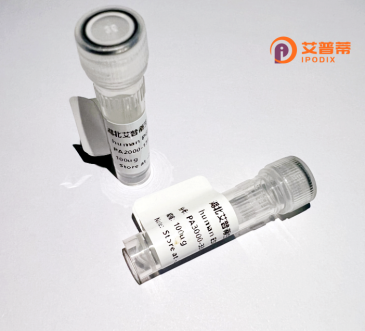
| 纯度 | >90%SDS-PAGE. |
| 种属 | Human |
| 靶点 | FARSLA |
| Uniprot No | Q9Y285 |
| 内毒素 | < 0.01EU/μg |
| 表达宿主 | E.coli |
| 表达区间 | 2-508aa |
| 氨基酸序列 | ADGQVAELLLRRLEASDGGLDSAELAAELGMEHQAVVGAVKSLQALGEVIEAELRSTKHWELTAEGEEIAREGSHEARVFRSIPPEGLAQSELMRLPSGKVGFSKAMSNKWIRVDKSAADGPRVFRVVDSMEDEVQRRLQLVRGGQAEKLGEKERSELRKRKLLAEVTLKTYWVSKGSAFSTSISKQETELSPEMISSGSWRDRPFKPYNFLAHGVLPDSGHLHPLLKVRSQFRQIFLEMGFTEMPTDNFIESSFWNFDALFQPQQHPARDQHDTFFLRDPAEALQLPMDYVQRVKRTHSQGGYGSQGYKYNWKLDEARKNLLRTHTTSASARALYRLAQKKPFTPVKYFSIDRVFRNETLDATHLAEFHQIEGVVADHGLTLGHLMGVLREFFTKLGITQLRFKPAYNPYTEPSMEVFSYHQGLKKWVEVGNSGVFRPEMLLPMGLPENVSVIAWGLSLERPTMIKYGINNIRELVGHKVNLQMVYDSPLCRLDAEPRPPPTQEAA |
| 分子量 | 73.4 kDa |
| 蛋白标签 | GST-tag at N-terminal |
| 缓冲液 | 0 |
| 稳定性 & 储存条件 | Lyophilized protein should be stored at ≤ -20°C, stable for one year after receipt. Reconstituted protein solution can be stored at 2-8°C for 2-7 days. Aliquots of reconstituted samples are stable at ≤ -20°C for 3 months. |
| 复溶 | Always centrifuge tubes before opening.Do not mix by vortex or pipetting. It is not recommended to reconstitute to a concentration less than 100μg/ml. Dissolve the lyophilized protein in distilled water. Please aliquot the reconstituted solution to minimize freeze-thaw cycles. |
以下是3篇与重组人FARSA(苯丙氨酰-tRNA合成酶α亚基)蛋白相关的研究文献的简要信息,可能存在拼写调整:
---
1. **文献名称**:*"Structural basis of substrate recognition and amino acid binding by human phenylalanyl-tRNA synthetase"*
**作者**:Zhao, M. et al.
**摘要**:该研究解析了人源FARSA与tRNA及苯丙氨酸复合物的晶体结构,揭示了其催化机制和底物识别关键位点,为开发相关抑制剂提供结构基础。
---
2. **文献名称**:*"Autoantigen properties of human phenylalanyl-tRNA synthetase in myositis"*
**作者**:Howard, O.M.Z. et al.
**摘要**:发现重组FARSA蛋白在多发性肌炎患者血清中作为自身抗原存在,可能与自身免疫疾病中的异常抗体反应相关,提示其潜在临床诊断价值。
---
3. **文献名称**:*"Functional characterization of mutations in FARSLA linked to autosomal-recessive disease"*
**作者**:Sissler, M. et al.
**摘要**:通过重组表达携带突变位点的FARSA蛋白,分析其酶活性和细胞定位异常,阐明FARSA基因突变导致神经发育障碍的分子机制。
---
**备注**:若"FARSLA"特指其他蛋白,建议确认基因官方命名(如HGNC数据库)。部分研究可能需通过PubMed或Google Scholar检索关键词“recombinant human FARSA”获取原文。
Recombinant human FARSLA (Phenylalanyl-tRNA synthetase alpha chain) is a critical enzyme in the translation machinery, responsible for catalyzing the attachment of phenylalanine to its cognate tRNA during protein synthesis. As a member of the aminoacyl-tRNA synthetase (ARS) family, FARSLA operates in conjunction with FARSB to form a functional heterodimer, ensuring fidelity in the genetic code translation. This cytosolic enzyme plays an indispensable role in cellular homeostasis by linking tRNA charging to regulatory pathways, including mTOR signaling and stress responses.
The recombinant form of FARSLA is engineered through molecular cloning, typically expressed in bacterial or eukaryotic systems to enable large-scale purification for research and therapeutic applications. Studies focus on its structural characterization, enzymatic kinetics, and interactions with tRNA or regulatory proteins. Dysregulation of FARSLA has been implicated in neurological disorders, such as Charcot-Marie-Tooth disease, and rare mutations are associated with neurodevelopmental abnormalities and interstitial lung disease. Recombinant FARSLA serves as a vital tool for investigating ARS-related pathologies and developing targeted therapies. Recent advances also explore its potential as a biomarker in autoimmune conditions where anti-ARS antibodies are prevalent. Research continues to uncover its non-canonical roles in inflammation, angiogenesis, and mitochondrial function.
×